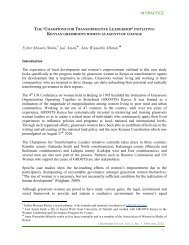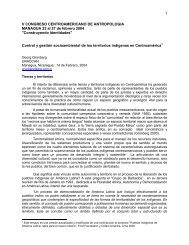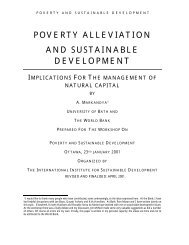The Cluster Initiative Greenbook
The Cluster Initiative Greenbook
The Cluster Initiative Greenbook
You also want an ePaper? Increase the reach of your titles
YUMPU automatically turns print PDFs into web optimized ePapers that Google loves.
Foreword<br />
by Professor Michael E. Porter<br />
<strong>The</strong> concept of clusters has emerged as a central idea in competitiveness and economic<br />
development over the last decade. Drawing on a long tradition of literature, the reasons<br />
for cluster formation and the benefits of clusters for productivity and innovation are<br />
becoming better known. 1 A large and growing body of case studies has documented<br />
clusters, their characteristics, and their evolution over time. 2 More recently, efforts to<br />
analyze clusters statistically are beginning, 3 but are still hampered by data limitations,<br />
especially outside the United States.<br />
As the understanding of clusters has grown, clusters have become a prevalent component<br />
of national and regional economic development plans. Hundreds of cluster<br />
initiatives have been launched involving virtually all region of the world, and the number<br />
is growing. <strong>The</strong>se initiatives, which take a wide variety of forms, are now an accepted<br />
part of economic development. However, we have surprisingly little systematic knowledge<br />
of these initiatives, their structure, and their outcomes. As more and more resources<br />
are devoted to efforts to foster cluster development, the need to understand best<br />
practices has become urgent.<br />
This <strong>Cluster</strong> <strong>Initiative</strong> <strong>Greenbook</strong> is a pioneering effort to fill this gap. It assembles,<br />
for the first time, survey evidence on a large sample of cluster initiatives. This data<br />
allows an analysis of the different shapes of cluster initiatives, how they evolve over<br />
time, and some of the factors that appear to influence their success and failure. While<br />
data limitations preclude definitive findings regarding the performance of cluster initiatives,<br />
then, the <strong>Greenbook</strong> provides much helpful and suggestive evidence. It also contains<br />
more in-depth descriptions of some aspects of cluster initiatives that experience reveals<br />
to be important to success.<br />
Having participated in many dozens of cluster initiatives since the publication of <strong>The</strong><br />
Competitive Advantage of Nations in 1990, the findings and suggestions here ring true.<br />
While we still have much to learn about translating the concept of clusters into practice,<br />
this volume takes us a big step forward.<br />
Boston, August 2003<br />
Michael E. Porter<br />
1<br />
For a literature survey and summary of the theory, see M.E. Porter, “<strong>Cluster</strong>s and Competition: New<br />
Agendas for Companies, Governments, and Institutions” in On Competition, Boston: Harvard Business<br />
School Press (1998).<br />
2<br />
See the bibliography of cluster profiles by Claas van der Linde available at http://data.isc.hbs.edu/<br />
cp/index.jsp<br />
3<br />
See M.E. Porter, <strong>The</strong> Economic Performance of Regions, Regional Studies, pp. 549-478, Vol. 37. 6&7,<br />
2003.<br />
<strong>The</strong> <strong>Cluster</strong> <strong>Initiative</strong> <strong>Greenbook</strong> • 5

















